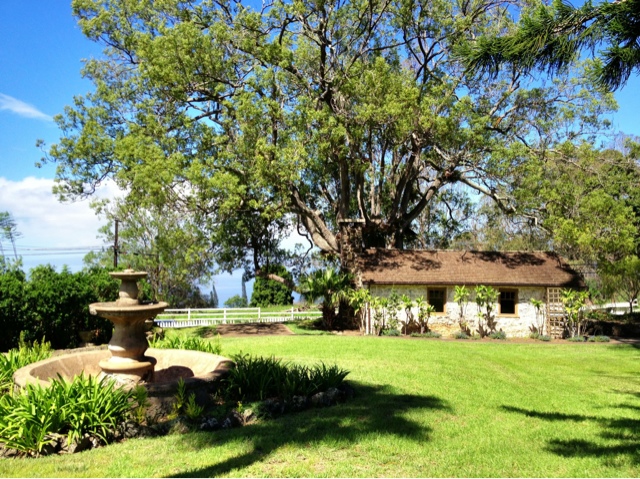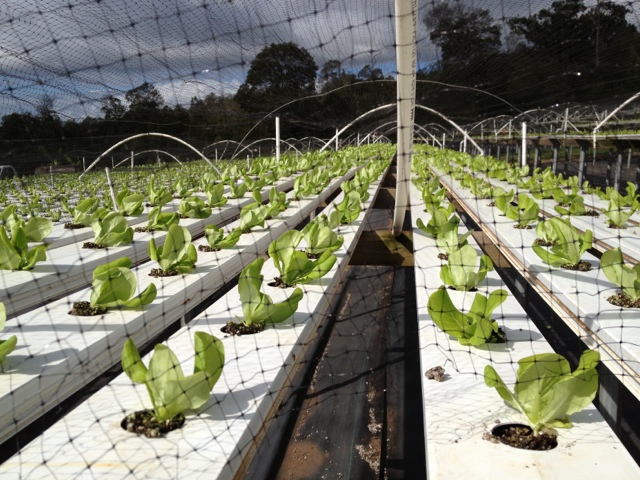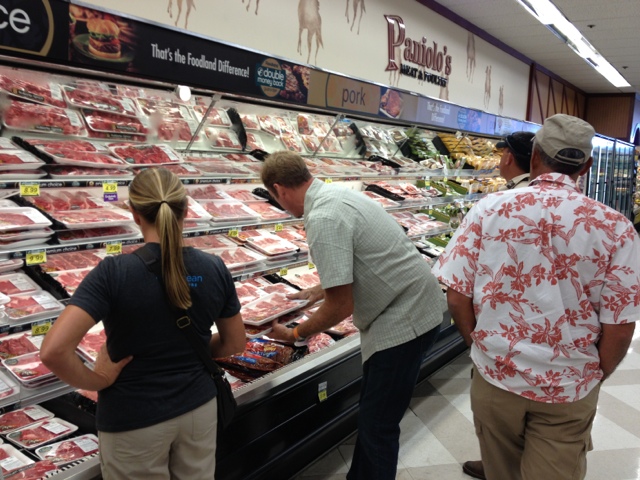How fortunate we were to be in the presence of the "canoe" koa and native forest in Waikamoi Preserve.
Monday, August 19, 2013
Sunday, August 18, 2013
Seminar 4 - Day 3 - From Haleakala to Mauna Kahalawai
Class XIV started our third day on Maui with a visit and hike into Haleakala Ranch's Waikamoi Preserve, with Pat Biley of The Nature Conservancy.
 |
| Pat explaining the trial process of using the Secusio moth to mitigate fireweed growth. |
The Waikamoi Preserve is a home to many native and endangered species, with portions of the Preserve considered pristine Hawaiian forests.
 |
| Syndey prepping to enter the Preserve by scrubbing his shoes free of possible hitchhiker organisms. |
 |
| Close up of Kahili Ginger. |
 |
| Ashley and Tina, dwarfed by a Koa considered to be a "Canoe Koa" - one that would have been considered as part of the process of historic and traditional canoe building. |
 |
| Surprise! Judith caught this "snake" on the way down, saving Cynthia's life. |
Our second stop of the day was to Ocean Organic Vodka, a family owned and operated certified organic farm and vodka distillery.
 |
| View of the farm and distillery from The Point, an area being cultivated for functions and other uses. |
 |
| Shonna Pinheiro led us on the farm tour, and dropped a lot of knowledge on us related to spirit distillation. |
 |
| the distillery! interesting note: all cleaning in the facility is done with the waste alcohol of the distillation process, to maintain organic status and to minimize waste |
 |
| ....the bottling room |
 |
| Grass taller than Kirby - unbelievable! |
 |
| Chris, Ashley, and James relaxing in the meditation garden next to the distillery. |
 |
| Pauline enjoying an Ocean Organic Vodka-infused truffle.... but was it as good as Tina's? |
After Ocean Organic Vodka, the class headed down to Wailuku, returning to 'Iao Valley to check in to The Hawaii Nature Center housing facility. Mauna Kahalawai is the mountain that is commonly referred to as "West Maui Mountain(s)", home of the famous Na Wai 'Eha.
 |
| A bonus attraction of the Maui Alumni Dinner - "cattle" roping! |
 |
| Thanks to Avery for hosting us at his Makani Olu ranch. Mahalo piha to the entire Maui Alumni network for such a wonderful gathering! |
Friday, August 16, 2013
Seminar 4 - Day 2 continued!
The group headed Upcountry to visit Tedeschi Winery and Ulupalakua Ranch.
We were lucky it was a bottling day at the winery. Hearing about the diversification of agriculture at Ulupalakua was really interesting for the group....always thinking forward while preserving the past.
After a great lunch with local meat at the ranch, we were off to Ali'i Kula Lavender Farm. It is fantastic seeing the next generation with so much passion for Hawaii's agriculture and their beautiful farm.
Staying in the area, we then headed to Waipoli Hydroponics. The lettuce is beautiful growing in this system...and at the commercial scale.
Last stop of the day....shopping for a group dinner. We seemed to manage to pull together a great dinner for doing a little group down time.
Another fantastic ALP day!
Seminar 4 - Day 2 Maui!
Started our morning with sweets from Komoda Bakery and coffee...all revved up and off to start our day!
Thursday, August 15, 2013
Seminar 4 - A Sweet First Day on the Valley Isle
A sweet first day on the Valley Isle.
Our first day on Maui started off at Hawaii Commercial &
Sugar Company, Hawaii’s last sugar plantation.
We heard about everything HC&S from Rick Volner, Plantation General
Manager.
 |
| Rick Volner, Plantation General Manager. |
Robert Lu’uwai, VP of Farm Operations led us on an extensive, but not long enough tour of the mill.
You could feel, hear, and smell the mill at work. HC&S has truly embraced technology, from the automation of some processes allowing for a reduction in labor costs, investment in computer software to monitor mill mechanical efficiency and safety, and use of new methods in the field.
 |
| Robert showing us the evaporators, which consume the largest amount of energy in the plant. |
Every
time I pour some raw sugar in my coffee, I’ll think about all the processes
involved to get to that little brown packet of sugar in Starbucks.
After returning to
the meeting room, we had a few short minutes to hear from Garret Hew from East
Maui Irrigation. The 75 miles of ditch
and tunnel irrigation system serves not only the plantation but the Kula Ag
Park and thousands of upcountry residents as well. Maui's dependence on surface water is such a huge factor in the future of agriculture on the island.
 |
| Garret Hew of East Maui Irrigation. |
This was
a great transition to our visit with Skippy Hau, Aquatic Biologist at DLNR’s
Division of Aquatic Resources. The venue was perfect, nestled in the valley with 'Iao stream flowing nearby.
 |
| 'Iao Stream. You rarely see water that clear and clean looking on O'ahu! |
 |
| Skippy Hau describing the different species of o'opu found in Maui streams. |
Skippy
shared with us about the effects of channelization and stream diversion on the
native biota. It’s amazing to think that
aquatic fauna like o’opu, ‘opae, and hihiwai, with the effects so evident, will
probably never be listed as a threatened or endangered species. He stressed that this was why stream
restoration is so vital to their recovery.
 |
| Hihiwai. |
“Humans don’t have the patience to wait for
change, we want it to happen all at once.”
We
headed up to Makawao to the baseyard for Maui Invasive Species Committee (MISC)
and the East Maui Watershed Partnership.
While we waited for Dr. Leary to arrive, Chuck Chimera, Weed Risk
Assessment specialist, gave us a quick tour of the small but growing native
garden for use in helping determine which native species axis deer are most
attracted to.
 |
| Tour of the native garden at MISC with Chuck Chimera. |
Dr.
James Leary from CTAHR arrived back at the baseyard from morning in the field
utilizing an innovative application method termed “Herbicide Ballistic
Technology” or HBT. HBT is basically
using an herbicide diluted with surfactants and encapsulated in a “paintball”
applied from a helicopter. Using this
method allows precise applications in hard or sometimes impossible to reach
areas – this has been so important in controlling incipient populations of
Miconia. What a unique and exciting
strategy in controlling spread of one of Hawaii’s most invasive pests, combining
surveillance and treatment! Tyler suggested
adding ecotourism into that mix. I think
I’ll suggest that to Dr. Leary and volunteer to be the first test subject!
 |
| Dr. James Leary describing the HBT application method. |
Dr.
Leary even let us have a shot (yes, pun intended) at this “application method”,
with some people showing off their shooting skills and others just wanting to
hear the sound of the gun on full automatic (ahem, Jennica).
 |
| Brandi and Kirby first to give it a try. |
After returning to the yurts, we had the opportunity to hear from Teya Penniman, Manager at MISC, which receives over $1 million in funding from Maui County, by far the most of any county invasive species committee. On the top of the list for MISC is control of invasive pests such as the Little Fire Ant, Coqui frog, banana bunchy top. Teya mentioned that most instrumental in their efforts is public reporting. 643-PEST!!
Abe
Vandenberg of MISC shared with us a new curriculum program available for high
school teachers, providing educator workshops on the natural environment of
Hawaii, exploring the different climate types Hawaii has to offer. What a great resource for Maui’s teachers! http://www.hoikecurriculum.org/
Next, we
heard from Mike Tavares of the Maui Axis Deer Harvesting Cooperative. Funded through the Offices of Economic Development,
this deer management program is available to the community and strives for “zero
waste”, utilizing every part of the animal.
It is because of this zero waste factor that MADHC has experienced
little to no public resistance. Looking
forward to some venison and one of those shirts!
After
this exciting day, we all headed to Banyan Tree House Bed & Breakfast for
the night. A great first day on Maui!
Subscribe to:
Posts (Atom)






























